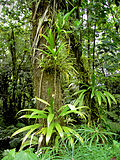Habitat
A habitat is the area in which an organism lives. It is a summary term for all the resources, physical and living which are present in an area.[1][2] It is the natural environment in which an organism lives, and the physical environment which surrounds a population.[3]
Animal habitats
Most animals live in one type of environment because they are best suited to it. We say they are 'adapted to this environment'. For example, animals such as frogs, newts, and ducks have webbed feet to help them swim in the water. There are many different types of habitats and many kinds of adaptations to each habitat.
If the habitat changes, it may no longer be suitable for the animals and plants that live there. Climate change is making some habitats warmer, and so many animal species are moving to cooler areas.[4] However some species are not able to move and the populations are getting smaller. Scientists think that 10% of species may become extinct because of these changes.[4] Other habitats have been cleared to make them into farm land. In Australia for example, 80% of the eucalypt forests have been cleared for farming over the last 210 years.[5] This is threatening the survival of forest animals such as the koala.
Plant habitats
Just as animals adapt to the places they live, so do plants. Plants are adapted to a wide variety of habitats. As a result, each plant has certain characteristics. Some are adapted to living on land while others live in water. Plants that grow on land usually have stiff stems to hold them upright, while water plants tend to have less rigid stems because the water supports them.
Plants that live in dry climates like the desert have few or no leaves. Many, such as cacti, store water when rain occurs. Their adaptations save water. Plants that grow in shaded areas have large leaves to capture as much sunlight as possible, or they climb towards the light.
Habitat Media
This coral reef in the Phoenix Islands Protected Area provides habitat for numerous marine species.
Few creatures make the ice shelves of Antarctica their habitat, but water beneath the ice can provide habitat for multiple species. Animals such as penguins have adapted to live in very cold conditions.
Ibex in an alpine habitat
Rich rainforest habitat in Dominica
The leaves of an Alnus nepalensis tree provide a microhabitat for species like the leaf beetle Aulacophora indica.
Twenty-five years after the devastating eruption at Mount St. Helens, United States, pioneer species have moved in.
Related pages
References
- ↑ "Habitat". Merriam-Webster. Retrieved 15 June 2012.
- ↑ Abercrombie, M.; Hickman, C.J.; Johnson, M.L (1966). A dictionary of biology. London: Penguin.
- ↑ "Living things: habitats and ecosystems". The Franklin Institute. Archived from the original on 8 April 2014. Retrieved 29 June 2011.
- ↑ 4.0 4.1 Harvey, Fiona (18 August 2011). "Climate change driving species out of habitats much faster than expected". The Guardian (London: GMG). . . http://www.guardian.co.uk/environment/2011/aug/18/climate-change-species-habitats. Retrieved 18 November 2012.
- ↑ "Land Clearing & Koalas". Australian Koala Foundation. 2012. Retrieved 18 November 2012.









